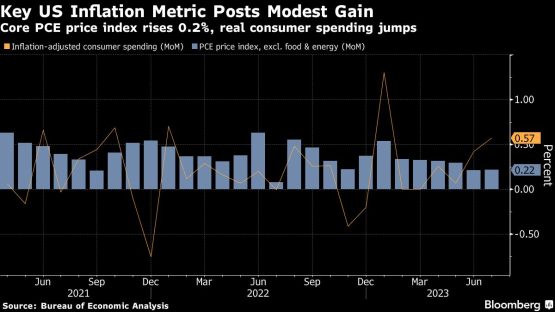The Federal Reserve’s preferred measure of underlying inflation posted the smallest back-to-back increases since late 2020, encouraging a burst of consumer spending and feeding growing expectations that the economy can avert a recession.
The core personal consumption expenditures price index, which strips out the volatile food and energy components, rose 0.2% in July for a second month. The overall PCE price index also increased 0.2%, Bureau of Economic Analysis data showed Thursday.

Inflation-adjusted consumer spending increased 0.6% last month on the heels of a solid gain in June. That was the strongest advance since the start of the year.
The subdued inflation figures underscore the progress the Fed has made over the past year in taming price pressures. That said, the central bank is far from declaring victory, and the strength of consumer spending presents a fresh concern for policymakers seeking to ensure inflation continues to dissipate.
Low unemployment, pandemic-era savings and wage growth are providing Americans the wherewithal to keep spending, allowing the economy to power ahead. Many economists have had to push out their recession calls, or in some cases, scrap them altogether as a result. The latest figures point to a strong start to economic growth in the third quarter.
| Metric | Actual | Est. |
|---|---|---|
| Real consumer spending (MoM) | +0.6% | +0.5% |
| PCE price index (MoM) | +0.2% | +0.2% |
| Core PCE price index (MoM) | +0.2% | +0.2% |
| PCE price index (YoY) | +3.3% | +3.3% |
| Core PCE price index (YoY) | +4.2% | +4.2% |
Separate data Thursday showed applications for unemployment benefits fell to a four-week low, while continuing claims edged up.
US stock futures remained higher and Treasury yields fluctuated after the report.
While wages and salaries rose in July, real disposable income, the main support to consumer spending, fell 0.2% on a decline in government transfer receipts.
One worrisome figure in the report was a measure of services costs closely watched by Fed officials. The gauge that tracks services inflation excluding housing and energy jumped 0.5% in July, the biggest advance since the start of the year, according to Bloomberg calculations.
The figure was distorted by an outsize increase in portfolio management and investment advice. Excluding that category, the so-called supercore services inflation measure rose 0.25% from a month earlier.
Inflation-adjusted outlays for goods increased 0.9%, the most since January, boosted by robust spending on a range of goods in the month. Services spending advanced 0.4%, an acceleration from the prior month and reflecting outlays for meals out, health care, as well as a flurry of spending for concerts and movies like Barbie and Oppenheimer.
The saving rate decreased to 3.5%, the lowest since November, suggesting the recent pace of spending may not be sustained in coming months.
Pandemic-era savings are dwindling, the labour market is cooling, delinquency rates are rising and the resumption of student loan payments this fall threatens to further strain consumers’ finances. Retail executives have suggested as much and remain cautious about the outlook.
From a year ago, the Fed’s preferred inflation metrics picked up. That said, the increase is a function of the way the measure is calculated, as the current month is compared to the sharp slowdown in price growth seen in July 2022.
© 2023 Bloomberg


